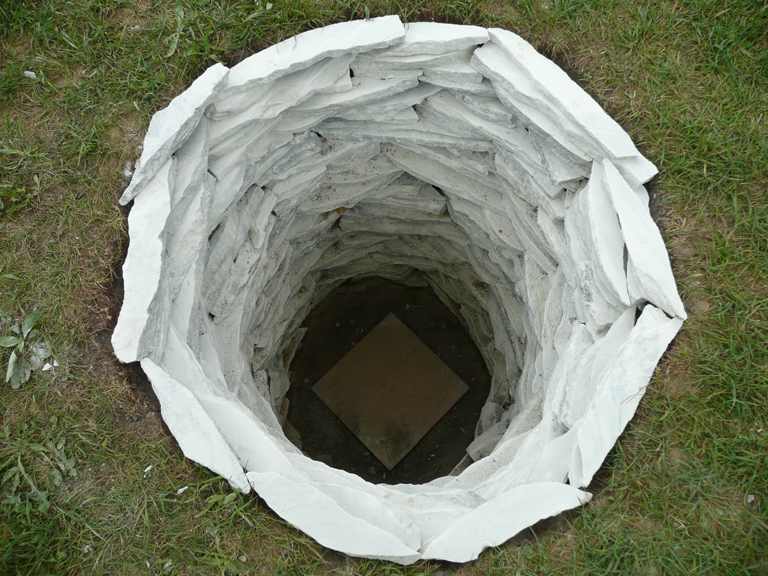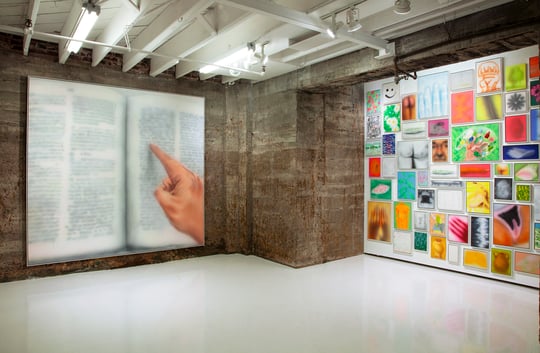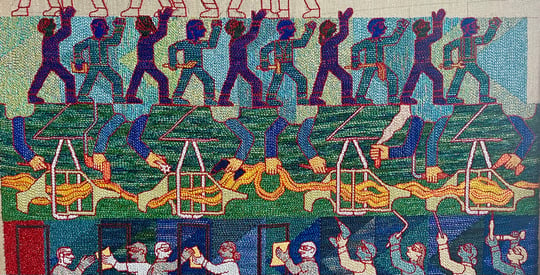
The Athens Institute for Contemporary Art’s current exhibition, “The Third Act: Contemplating Aging,” attempts to say a great deal about aging in contemporary society, specifically the time closer to death than birth. Confronting such dense subjects in small spaces like this can result in nothing of substance being said, but this show finds strength in the rich correspondences between particular pairs of works throughout the gallery. The exhibition’s impact derives from these smaller conversations among its nine artists.
Constant shifts in tone, medium, and perspective often seem sprawling and disconnected, but the connections that can subtly arise between two works engender a provocative network of ideas. For instance, the narrow scale of Karen Hymer’s gravure prints abstracts aging bodies to the point where skin texture become indistinguishable from the fabric around it. This microscopic, impersonal perspective of the human body finds a divergent counterpart several feet away in a painting by Lisa Freeman that also exposes the elderly nude, though with a fiery splattering of yellows and reds that celebrate the metaphysical spirit within even the most weathered body.

Commissioned by a pharmaceutical company to promote its medication for Alzheimer’s, Tom Hussey’s photographs of elderly men and women regarding mirror reflections of their younger selves spotlight the importance of memories while aging. The gallery setting, however, lays bare the commercial appeal, and the staged details of these domestic scenes become contemplative rather than persuasive. In the face of these ghosts and to actual photographs that decorate most of the interiors, these images declare so firmly the importance of retaining the past as to also emphasize its opposite: the forward-looking act of creating memories, even in the ebb of life..
With every detail in Hussey’s photographs popping, focus shifts from objects to interactions between figures. Here, the presence of onlookers—ostensibly relatives or professional caregivers—represents the most common theme in “The Third Act,” that of aging’s effect beyond the ailing individual.

Photographs and diagrams document Cecelia Kane’s “The Mother Hole,” a well lined with marble stones that she dug after her mother’s death in an act of contemplation and expression of her own physicality Associations with grave-digging and mausoleum-building echo humanity’s coping with death through funereal ritual. The artist-as-caregiver also appears in the sculptures of Ann Rowles, who crocheted shapes of osteoporotic bones while waiting in doctors’ offices and at her mother’s bedside.
These points of correspondence appear most succinctly in Peter Nelson’s video installation On Dying. A series of interviews with elderly subjects expounding upon death and aging comes out of the mouths of lip-synching 20-something actors. These segments fully explore the transcending impact of death across age boundaries, as the juxtaposition between voice and mouth create a disjointed effect. Furthermore, the narratives of these aged interviewees often recount personal experiences of dying companions, sometimes even of childhood memories of death, a then distant notion still potent enough to haunt youthful eyes. These layers of age, history, and reflection sustain much of the exhibition.

Another acute point of correspondence occurs between a tennis-ball-modified walker that holds John English’s gag products and a dissected wheelchair that frames Malena Bergmann’s kinetic sculpture, Final Hour: Compline, which provided the impetus for “The Third Act.” It consists of a scrolling EKG strip that prompts a slowly turning wheel, tugging strings that jolt and vibrate medical tubing loosely hung from the rack above. Framed by the two pieces of wheelchair, the sculpture distills the transcribed spark of life into a mechanized surrogate for human biology. This transposition evokes the loss of agency that accompanies age, as one cedes more independence to machines and human caregivers.
Although not in distinct dialogue with other works in the show, Final Hour: Compline serves as a succinct centerpiece for many of the tensions at play in the gallery. Emitting noises neither soothing, like the hum of a fan, nor as dramatic as the crank of an ascending roller coaster, the piece maintains a stoic bedside manner. While the artist took inspiration from her personal experience of caring for her ailing stepmother, her use of an anonymous, dying woman’s EKG, mysteriously received in the mail, provides an impersonal element that resonates with the more abstract concept of death on a human scale.
This final, industrial portrayal of the body again questions the true material of life, whether it be gears and pumps or memories lived and retained. The looming steel contraption suggests the clinical accoutrements of a life-near-death and the contrasting desire of many aging individuals who wish to experience their final days at home. In this hospital not only of machines but of memories and memorials, the patron assumes the role of caregiver, faced abruptly with the mortal limits of human experience.
“The Third Act: Contemplating Aging” is on view through March 2.
Taylor Hobson is a master’s candidate in the department of art history at the University of Georgia. He currently lives in Athens.







